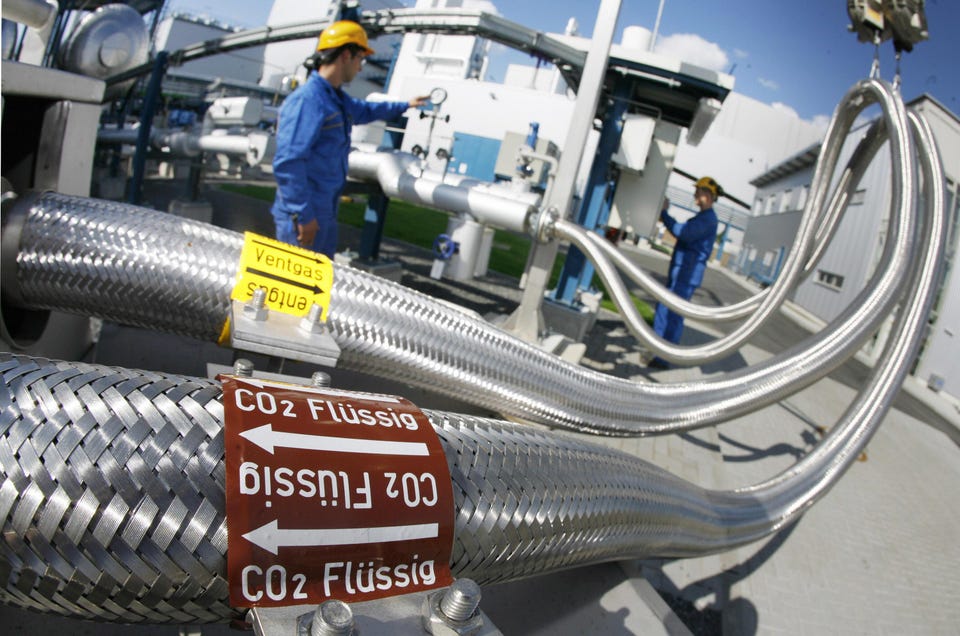Sustainability Carbon Capture Surges In 2022, But Not Nearly Enough Jeff McMahon Senior Contributor Opinions expressed by Forbes Contributors are their own. From Chicago, I write about climate change, green technology, energy. Following New! Follow this author to stay notified about their latest stories.
Got it! Oct 23, 2022, 12:47am EDT | New! Click on the conversation bubble to join the conversation Got it! Share to Facebook Share to Twitter Share to Linkedin Two employees work on pipes carrying liquid CO2 at the “Schwarze Pumpe” power station run by the . . .
[+] power company Vattenfall near Berlin. The Swedish firm is using Carbon Capture and Storage, or CCS, which captures the greenhouse gases produced when coal at this plant is burned, preventing the gases from escaping into the Earth’s atmosphere and contributing to global warming. (MICHAEL URBAN/DDP/AFP via Getty Images) DDP/AFP via Getty Images The number of carbon capture and storage facilities planned across the globe grew by 44 percent in 2022—an impressive sounding surge for an industry but only a tiny fraction of the CCS development needed for the world to achieve net-zero carbon emissions by mid century.
“Although the increasing deployment of CCS we see is encouraging, we’re still far short of the scale required to achieve and help achieve net zero,” said Jarad Daniel, CEO of the Global CCS Institute, which released its Global Status of CCS 2022 report last week. “The installed capacity of CCS still needs to increase by at least 100 fold between now and 2050 to help meet our climate goals. ” There are 196 CCS projects “in the pipeline,” according to the report, which translates to 30 in operation, 11 under construction, 153 in development and 2 that are suspended.
Most of the 2022 growth occurred in the United States, with 34 new projects in the pipeline. Canada is second with 19. The capture capacity of all those projects is about 242 million tons per year.
The Global CCS Institute has said capacity must reach 425–650 million tonnes per year by mid-century, but the International Energy Agency has said capacity must reach 1. 6 billion tons per year by 2030. CCS has done best in the U.
S. thanks to promotion by the U. S.
Department of Energy. “There are really hard to decarbonize sectors,” said Jennifer Wilcox, the principal deputy assistant secretary in DOE’s Office of Fossil Energy and Carbon Management, formerly known as the Office of Fossil Energy. DOE added the words “carbon management” to the office’s name on July 4, 2021.
MORE FOR YOU Hiring Refugees: How One Big Factory Did It Designer Morgan Brown Lists West Hollywood Compound For $16. 9 Million What Happens When The Interest Rate Tsunami Hits Consumers? “We will need CO2 removal from the accumulated pool of CO2 in the atmosphere to help to counterbalance truly hard to decarbonize sectors,” Wilcox said in a webinar hosted by the Oil and Gas Climate Initiative. “That carbon removal shouldn’t be seen as a tool to offset emissions that we actually have the ability to avoid today in terms of carbon capture.
” For example, she said, the cement industry has two sources of emissions that are difficult to address but are best addressed with capture rather than removal. “When you think about cement, it’s a combination of a chemical reaction where we calcine limestone, and so that chemical reaction produces CO2, and those are called process emissions. But it’s combined with fuel emissions as well, and so in the case of retrofitting a cement plant with carbon capture you achieve deep reduction of not just the process emissions but also the combustion emissions.
” So Wilcox differentiates between carbon capture and carbon removal. Carbon removal, she said, should be reserved to offset emissions from “truly hard to decarbonize sectors” such as agriculture, aviation, shipping, and long-haul trucking. “Carbon capture is a critical tool for some of the industrial sectors for committed power infrastructure, but it’s a different tool from carbon removal, and U.
S long-term climate strategy shows that we will ultimately need both of these tools in order to achieve net zero. ” Neither are yet developing quickly enough, Daniel said: “Global efforts to reduce emissions, including investment in CCS, are still grossly inadequate. ” Follow me on Twitter or LinkedIn .
Check out my website . Jeff McMahon Editorial Standards Print Reprints & Permissions.
From: forbes
URL: https://www.forbes.com/sites/jeffmcmahon/2022/10/23/carbon-capture-surges-in-2022-but-not-nearly-enough/
